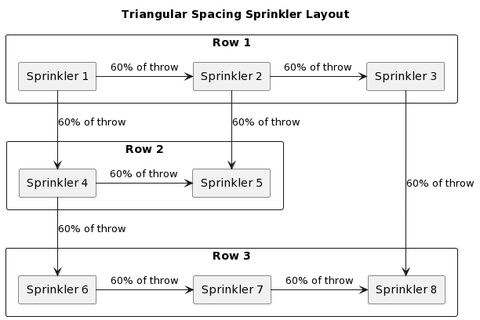
The Secrets Behind Successful Sprinkler Spacing and Design
At Big Frog Supply, we understand that the key to achieving a lush, green lawn and thriving plants is an efficient and properly designed irrigation system. If you've recently installed a sprinkler system but are experiencing issues like brown, dry spots or overwatering in certain areas, it's likely due to improper spacing between your rotors and sprays.
In this comprehensive guide, we will walk you through the essential steps to calculate and optimize the spacing of your irrigation system, ensuring optimal performance and water efficiency.
The Importance of Head-to-Head Coverage
When it comes to spacing your sprinkler system, the golden rule is "Head-to-Head coverage." This principle applies to both sprays and rotors, and it involves spacing the heads so that their water distribution overlaps from head to head.

By achieving head-to-head coverage, you ensure that every inch of your lawn receives adequate water, preventing dry brown spots and ensuring uniform irrigation.
When heads are too far apart, you'll end up with areas that are not covered, resulting in under-watering and unsightly dry patches. Conversely, if heads are too close together, overwatering can occur, leading to water waste and potential damage to plants. Therefore, it's crucial to calculate and plan the spacing of your system correctly.
Factors to Consider When Designing Spacing
Several factors come into play when designing the spacing of your sprinkler system. By taking these factors into account, you can create an efficient and tailored irrigation plan. Here are the key considerations:
-
Sprinkler Head Water Pressure: The water pressure available at each sprinkler head will affect its throw distance and coverage. Ensure that your system's water pressure is suitable for the chosen sprinkler heads.
-
Slope: If your yard has slopes, you need to consider the water runoff and adjust the spacing accordingly to ensure uniform coverage.
-
Location: Take into account any specific characteristics of your yard, such as shaded areas or areas exposed to strong winds, as these factors can impact the effectiveness of your irrigation system.
-
Type of Plants: Different plants have varying water requirements. Consider the water needs of the plants in each zone and adjust the spacing accordingly to provide adequate coverage.
-
Gallons Per Minute (GPM): Calculate the flow rate or GPM for each sprinkler head to ensure sufficient water supply and avoid overtaxing your system.
With these factors in mind, you can proceed to design the spacing of your sprinkler system based on the layout of your yard.
Spacing Considerations for Different Yard Layouts
Depending on the shape and dimensions of your yard, different spacing techniques can be employed to achieve optimal coverage. Here are some guidelines for various yard layouts:
Rectangular Spaces
For rectangular spaces, a straightforward approach can be taken to determine the spacing of your sprinkler heads. Start by marking the sprays in the corners of the area. If necessary, add sprays along the perimeter. Proportions of the area can simplify placement.
For example, a 30-by-60 foot lawn can be covered by six 30-foot rotors, with one rotor in each corner and one in the middle of each of the 60 ft sides.

If the dimensions do not divide precisely, you can calculate the spacing by adding a head in each corner followed by the fewest amount of heads required along the sides.
If the area exceeds the throw distance of your chosen sprinkler head, additional heads should be added down the middle of the section to ensure complete coverage.
Narrow Spaces
For narrow areas in your yard, such as strips or walkways, strip-pattern spray nozzles are the ideal solution. These nozzles disperse water in a rectangular pattern instead of a circular one.

To achieve head-to-head coverage, three shapes are used: side strip, center strip, and corner strip.
The side strip is positioned along the side of a long strip, while the center strip is positioned in the middle.
The corner strip is positioned in the corner, covering half of the side of the strip. Typically, strip patterns cover widths of 4 to 5 feet and lengths of up to 30 feet.
Irregular Spaces

For curvy or irregular areas in your yard, adjustable pattern nozzles are the most suitable. These nozzles allow you to adjust the spray throw to fit the area precisely.
In some cases, equally spaced heads may not fully cover an area, requiring the addition of an extra head with smaller or greater coverage to fill in the space.
When designing the spacing for irregular spaces, it's important to minimize overspray and avoid hitting surfaces that may be damaged by excessive moisture, such as your house, fences, or tree trunks.
Choosing Between Rotors and Sprays
The size of the area that needs to be irrigated is a crucial factor in determining whether to use rotors or spray heads for your sprinkler system. Both have their advantages and are suited for specific applications.
Rotors are ideal for larger areas due to their ability to cover a greater distance. They require fewer heads, reducing installation and maintenance costs.
Rotors can throw water as far as 70 feet, making them perfect for expansive landscapes. However, it's important to choose the appropriate rotor model that matches the throw distance required for your specific area.
Some medium-sized rotor models can deliver a minimum throw as small as 15 feet.
Sprays, on the other hand, are more suitable for smaller areas within your overall design plan. They have a shorter throw distance, typically ranging from 4 to 15 feet. Sprays work well for precise watering of smaller lawns, garden beds, or areas with delicate plants.
In many cases, a combination of rotors, sprays, and drip irrigation is recommended to ensure efficient and even coverage throughout the landscape.
Rotor and Spray Performance Guidelines
When planning your spacing, it's important to consider real-life factors such as wind and humidity, which may affect the performance of your sprinkler heads.
Manufacturer specifications often provide performance data based on controlled indoor environments, and it's essential to make adjustments to account for outdoor conditions.
As a general guideline, subtract an additional 10-15% from the recommended rotor or spray's maximum water throw to compensate for these factors.
For sprays, it's crucial not to turn them down more than 25% of their rated throw. Doing so can result in poor water distribution and inadequate coverage. Adhering to these guidelines will help ensure that your system performs optimally under real-world conditions.
Plotting Sprinkler Placement
To assist you in plotting the placement of your sprinkler heads, we offer two main spacing options: square spacing and triangular spacing (also known as staggered spacing). Let's explore each method:
Square Spacing

Square spacing is the simplest method to plot, but it may result in some areas being overwatered due to all four heads covering certain spots.
When using a square pattern, sprinklers are spaced relatively close together, typically around 50% of the diameter of the throw.
This means you will need more heads to cover any given area. Square spacing can be ideal for small, regular-shaped areas.
Triangular Spacing
Triangular spacing covers more surface area with less overlap, making it an efficient method for larger areas. To plot using a triangular pattern, start by choosing a side of the rectangular or square area as a baseline. Place a head in each corner, and then add a third head in between and across from the two heads you've already placed.

When plotting the next row, stagger the pattern similar to laying bricks. This method allows you to space the heads farther apart, usually around 60% of the diameter of the throw. Triangular spacing reduces the number of heads required and can save you money on installation and maintenance costs.
General Guidelines and Special Situations
Here are some additional guidelines and considerations for specific situations you may encounter while designing your sprinkler system:
-
Symmetrical Courtyard with a Walkway: To avoid watering the walkway, use a combination of spray patterns, such as 90-degree (quarter), 180-degree (half), and 360-degree (full) patterns. By strategically placing the spray patterns, you can ensure that both the lawn and walkway receive proper coverage.
-
Working with Corners around a Building: When dealing with corners around a building or other obstacles, triangular spacing is especially useful. It allows you to avoid watering the obstacle while efficiently irrigating the surrounding areas.
-
Watering an Irregular Grouping of Plants: For irregularly shaped garden beds or plant groupings, adjust the spacing and pattern of spray heads to match the specific layout. By using adjustable pattern nozzles, you can customize the spray throw to cover each plant effectively.
-
Watering Both Hedges and Lawns: When you have a combination of hedges and lawns in your yard, using sprays on risers can ensure simultaneous watering. By adjusting the height and pattern of the sprays, you can achieve optimal coverage for both areas.
-
Reducing Water Loss on Corners: To minimize water loss on corners, adjust the throw distance of your sprinkler heads and consider the use of corner strip nozzles. This will prevent excessive water runoff and ensure efficient irrigation.
-
Irrigating Curved Areas: For curved areas like walkways or circular flower beds, adjust the placement and direction of the sprinkler heads to cover the inside or outside of the curved area effectively. By aligning the heads properly, you can avoid dry spots and ensure even watering.
Incorporating these guidelines and addressing special situations will result in a customized and efficient sprinkler system that meets the specific needs of your yard.
Designing and optimizing the spacing of your sprinkler system is crucial for achieving a healthy and vibrant landscape. By following the principles of head-to-head coverage, considering various factors, and utilizing appropriate spacing techniques, you can ensure that your irrigation system provides uniform watering while conserving water and minimizing wastage.

At Big Frog Supply, we are dedicated to helping you create and maintain a beautiful, thriving yard. By implementing the guidelines and techniques outlined in this comprehensive guide, you'll be on your way to achieving a top-notch performance for your sprinkler system.
For further assistance or to explore our range of irrigation supplies, please visit our website or contact our knowledgeable team. We're here to support you on your journey to a greener and healthier outdoor space.
FAQs
-
Why is head-to-head coverage important for sprinkler systems? Head-to-head coverage ensures that every part of your lawn receives adequate water, preventing dry spots and ensuring uniform irrigation.
-
What factors should I consider when designing the spacing of my sprinkler system? Factors to consider include sprinkler head water pressure, slope, location, type of plants, and gallons per minute (GPM).
-
Should I choose rotors or sprays for my sprinkler system? The choice depends on the size of the area you need to irrigate. Rotors are ideal for larger areas, while sprays work well for smaller areas and precise watering.
-
What are some spacing techniques for different yard layouts? For rectangular spaces, a straightforward approach can be used. Narrow spaces can benefit from strip-pattern spray nozzles, and irregular spaces can be handled with adjustable pattern nozzles.
-
How can I plot the placement of my sprinkler heads? Square spacing and triangular spacing are two main options. Square spacing is simpler but may result in overwatering, while triangular spacing covers more area efficiently.

Leave a comment